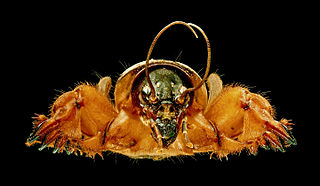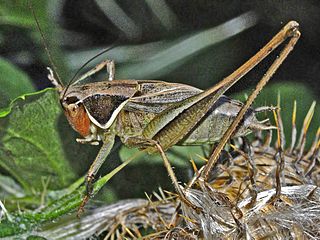
Insects in the family Tettigoniidae are commonly called katydids, or bush crickets. They have previously been known as "long-horned grasshoppers". More than 8,000 species are known. Part of the suborder Ensifera, the Tettigoniidae are the only extant (living) family in the superfamily Tettigonioidea.

Orthoptera is an order of insects that comprises the grasshoppers, locusts, and crickets, including closely related insects, such as the bush crickets or katydids and wētā. The order is subdivided into two suborders: Caelifera – grasshoppers, locusts, and close relatives; and Ensifera – crickets and close relatives.

The family Gryllidae contains the subfamilies and genera which entomologists now term true crickets. Having long, whip-like antennae, they belong to the Orthopteran suborder Ensifera, which has been greatly reduced in the last 100 years : taxa such as the spider-crickets and allies, sword-tail crickets, wood or ground crickets and scaly crickets have been elevated to family level. The type genus is Gryllus and the first use of the family name "Gryllidae" was by Walker.

Mole crickets are members of the insect family Gryllotalpidae, in the order Orthoptera. Mole crickets are cylindrical-bodied, fossorial insects about 3–5 cm (1.2–2.0 in) long as adults, with small eyes and shovel-like fore limbs highly developed for burrowing. They are present in many parts of the world and where they have arrived in new regions, may become agricultural pests.

Ensifera is a suborder of insects that includes the various types of crickets and their allies including: true crickets, camel crickets, bush crickets or katydids, grigs, weta and Cooloola monsters. This and the suborder Caelifera make up the order Orthoptera. Ensifera is believed to be a more ancient group than Caelifera, with its origins in the Carboniferous period, the split having occurred at the end of the Permian period. Unlike the Caelifera, the Ensifera contain numerous members that are partially carnivorous, feeding on other insects, as well as plants.

The Caelifera are a suborder of orthopteran insects. They include the grasshoppers and grasshopper-like insects, as well as other superfamilies classified with them: the ground-hoppers (Tetrigoidea) and pygmy mole crickets (Tridactyloidea). The latter should not be confused with the mole crickets (Gryllotalpidae), which belong to the other Orthopteran sub-order Ensifera.

Roesel's bush-cricket, Roeseliana roeselii is a European bush-cricket, named after August Johann Rösel von Rosenhof, a German entomologist.

The wart-biter is a bush-cricket in the family Tettigoniidae. Its common and scientific names derive from the eighteenth-century Swedish practice of allowing the crickets to nibble at warts to remove them.

Meconema thalassinum is an insect in the family Tettigoniidae known as the oak bush-cricket and drumming katydid. It is native to Europe, including the British Isles, and was introduced to the United States, first established in the west of Long Island and extending its range to Rhode Island and Scarsdale, Stony Brook, and Ithaca, New York.

Gryllotalpa gryllotalpa, commonly known as the European mole cricket, is widespread in Europe and has been introduced to the eastern United States. The scientific name is derived from the Latin 'gryllus' meaning a cricket and 'talpa', a mole, and is descriptive because of the fine dense fur by which it is covered and its subterranean habits, and because of the mole-like forelegs adapted for digging, a good example of convergent evolution.
Orthopteroids are insects which historically would have been included in the order Orthoptera and now may be placed in the Polyneoptera. When Carl Linnaeus started applying binomial names to animals in the 10th edition of his Systema Naturae in 1758, there were few animals included in the scheme, and consequently few groups. As more and more new species were discovered and differences recognised, the original groups proposed by Linnaeus were split up.

Saga hellenica is a large species of bush cricket or katydid in the family Tettigoniidae. It is endemic to the Balkans, living in Albania, North Macedonia, Greece and in the past also in western Bulgaria such as scrub and shrub spiny bushes.
Sam W. Heads is a British palaeontologist, a Fellow of the Linnean Society of London, a Fellow of the Royal Entomological Society, as well as a former Officer and Editor-in-Chief at the Orthopterists' Society.

Meconema meridionale is an insect in the family Tettigoniidae, known as the southern oak bush cricket.

Tetrix ceperoi, Cepero's groundhopper, is a member of the family Tetrigidae and is very similar to common grasshoppers. Grasshopper is defined as a "plant eating insect with long hind legs that are used for jumping and for producing a chirping sound". However, unlike the common grasshopper, the wings of T. ceperoi extend beyond its pronotum. The front wings have evolved throughout history to be stumps, and the back wings are very well developed. Thanks to the front wings only, T. ceperoi is capable of flying. Furthermore, T. ceperoi sports wide shoulders while covering its narrow abdomen beneath the pronotum. T. ceperoi are classified as Orthoptera, which describes crickets, grasshoppers, and locusts. Furthermore, these Orthoptera have incomplete metamorphosis, which also affects sexual dimorphism later. T. ceperoi reach an average length of about 10 millimetres (0.39 in). T. ceperoi is a multi-coloured ground dweller with the ability to blend into its surroundings. The ability of T. ceperoi to be different colours makes it able to evolve colour schemes better adapted to specific habitats. This cryptic nature of their outer layer provides protection from predators as it is able to blend into its surroundings. T. ceperoi is diurnal, which means it is solely active in the daytime. However, although it is diurnal, it continues to hibernate during a late nymphal instar or later on in life as adults.

Grylloidea is the superfamily of insects, in the order Orthoptera, known as crickets. It includes the "true crickets", scaly crickets, wood crickets and other families, some only known from fossils.

Sepiana sepium, common name sepia bush-cricket, is a species of bush crickets belonging to the subfamily Tettigoniinae and tribe Platycleidini. It is the only species within the monotypic genus Sepiana.

Roeseliana is a genus of bush cricket or katydid in the subfamily Tettigoniinae. Species in this genus were placed at various times in the genera Metrioptera and Bicolorana, until Roeseliana was restored in 2011.
















